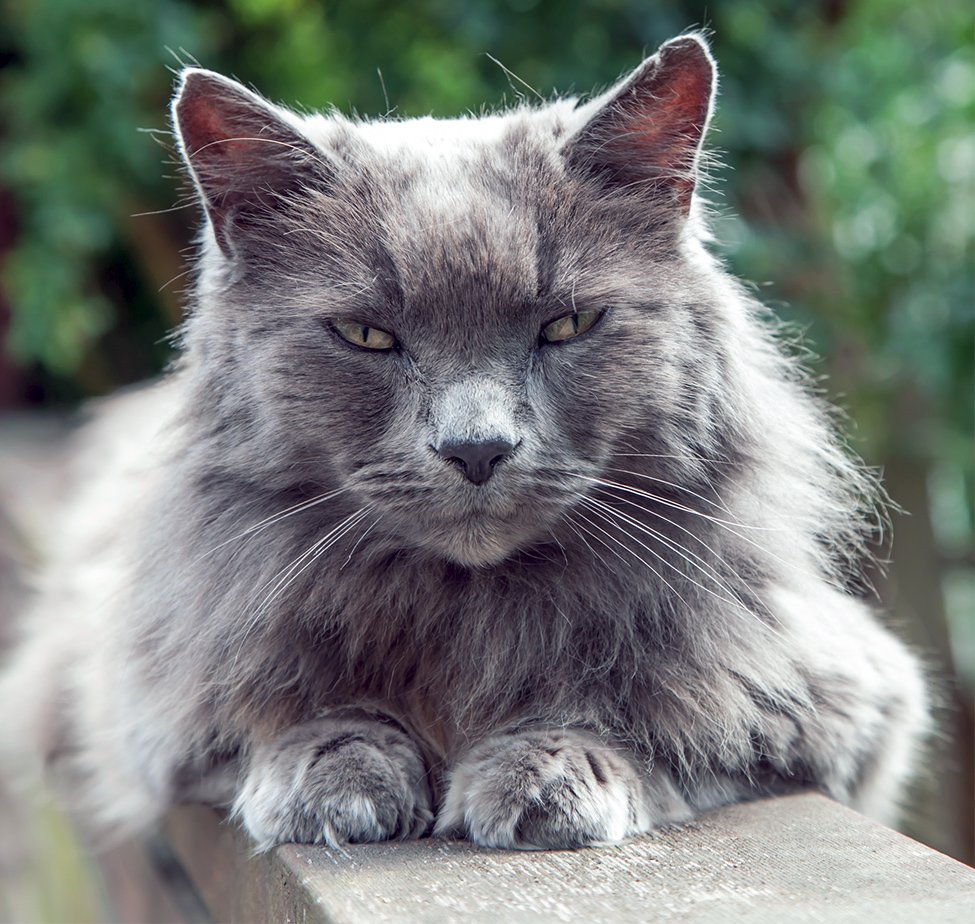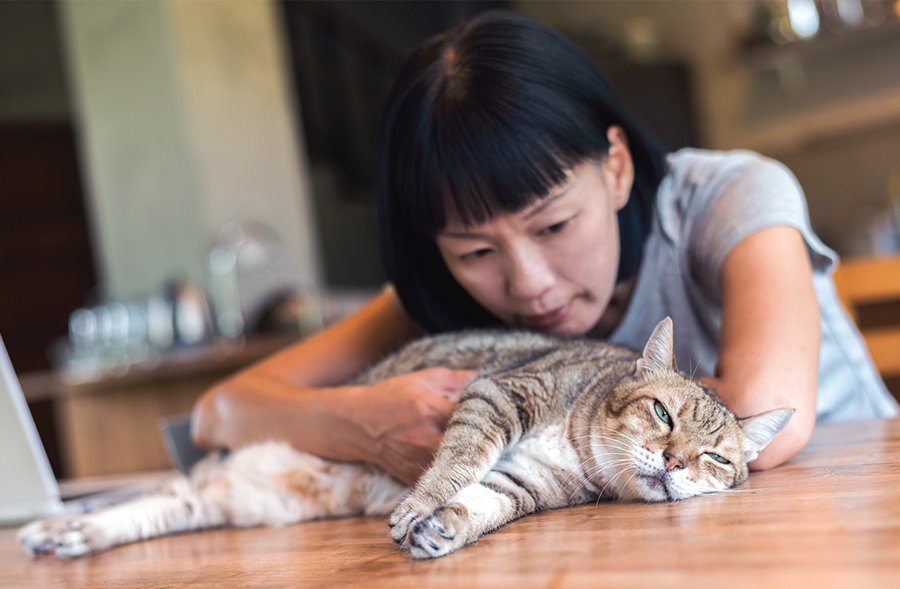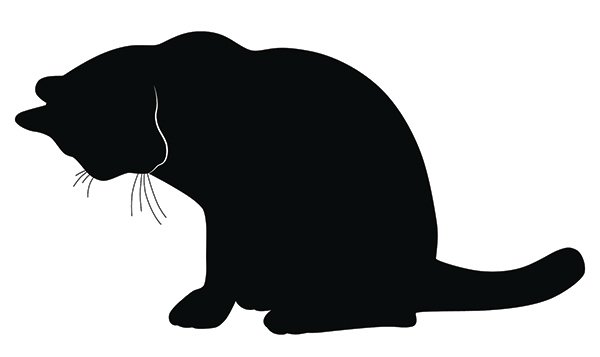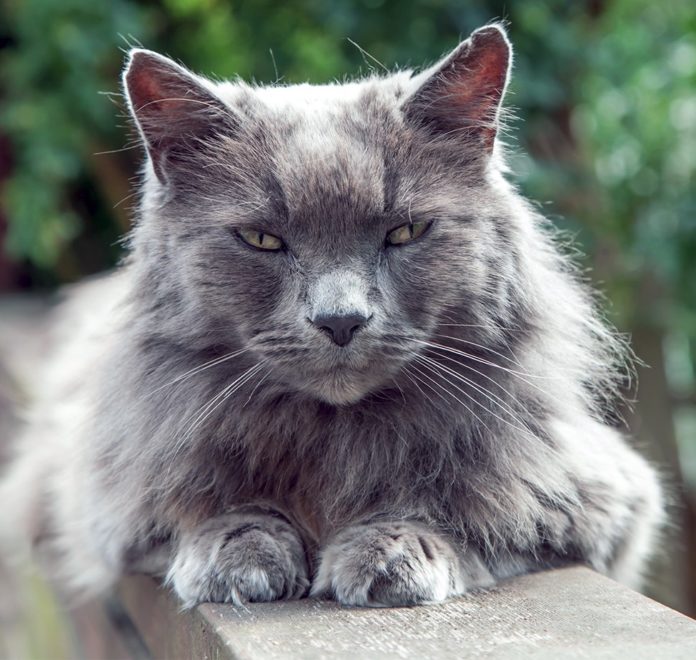Everyone hopes the day will never come, but at some point, you may notice that your cat is approaching the end of her life. When this happens, your goal becomes to keep her comfortable and happy for as long as possible.
sjallenphoto | Deposit Photos

The American Association of Feline Practitioners (AAFP) differentiates hospice and palliative care, but they are similar: “Hospice care is a system for providing comfort care to animals nearing the end of their life and emotional support for the clients who love them. Palliative care focuses on the relief of suffering while providing for the best quality of life regardless of the disease outcome.”
A cat needing hospice care may have a terminal or chronic illness or injuries that mean a decreased quality of life. Treatment may have been attempted and failed or perhaps treatment was not considered appropriate for this cat and her conditions.
When developing a palliative care plan for an individual cat, the essential Five Freedoms for quality of life should be considered. The Five Freedoms are:
1. Freedom from hunger, thirst, and malnutrition. Make sure your cat is eating a nutritious diet. While this may need to be adjusted for health problems (such as protein levels for a cat with kidney failure), basically you want your cat consuming appropriate foods. This may change over time. At some point, you may have to resort to “whatever she will eat.” It’s not unheard of for a cat at this stage to dine on canned shrimp alone.
Remember that feline appetites rely heavily on smell. Make sure your cat has a clean nose. When in doubt, choose food flavors that come with a stronger odor. Warming up the food can increase the scent. Always check the temperature before you serve the food. It should be lukewarm, not hot.
Short-term appetite stimulants can increase a cat’s appetite. Some need to be administered by your veterinarian. Mirtazapine can be formulated as a pill or a transdermal gel, which is applied to the inside of the ear to absorb through the skin.
Many families feel that when their cat can’t or won’t eat on her own it is time to consider euthanasia. Used short-term, feeding pureed foods that can be gently warmed and fed as a slurry can help a cat to maintain nutritional adequacy for a longer time.
You will need to experiment with both foods and fluids, trying items with a strong scent such as the juice from canned tuna or offering foods and drinks at different temperatures (always test to make sure foods are not too hot before feeding). Different flavors may induce consumption and the favored flavor may change from day to day.
The same is true for drinking. You need to provide plenty of options for fresh clean water. Always make sure your cat can access her water sources and food bowls. Don’t expect a senior cat to climb stairs or get up on a counter to eat or drink. Many senior cats benefit from subcutaneous fluids near the end of their lives, especially cats with kidney failure.
If your cat has been eating from dishes on the floor, try raising them up a bit. This might help a cat with arthritis in her neck to eat and drink more easily. A pet water fountain may entertain your cat and encourage more drinking.
2. Freedom from discomfort. One way to avoid discomfort is to keep your cat cool in hot weather and warm in cold weather. Frail, elderly cats tend to suffer from hypothermia more than being too warm. Extra padded beds around the house, soft blankets, and resting places set where patches of sunlight come through windows are appreciated by senior felines. Heating pads can be dangerous if your cat is too frail to move away if she gets too warm. Padded hot water bottles or frozen ones in hot weather are better ways to add to her comfort.
Some cats will lie on top of heat or air-conditioning vents, depending on the season, but many cats don’t like air blowing over them. A soft bed located near the vents could be appealing. Cats in hospice care should only go outside in catios or on a leash and harness and always with supervision.
Part of physical comfort could include the location of necessities such as food, water bowls, and litterboxes. Senior cats with arthritis and elderly cats who are frail with muscle loss will have trouble going up or down stairs. Even negotiating a high lip on a litterbox might be too much. Think about options such as a lipped cookie tray for a litterbox, and put newspaper under and around to catch litter, urine, or stool that gets kicked out or misses the mark. Placing ramps to provide access to preferred places such as a bed can also make things easier on elderly cats with arthritis.
For cats who tend to slip, strategic placement of nonskid rugs or mats can help keep them mobile but safe.
Self-grooming can become difficult for many old cats. Consider shaving areas that tend to mat, especially in long-haired cats. Choose quiet, cordless clippers, which are less frightening to cats. A cat who is used to being groomed will appreciate daily brushings. You may need to experiment to find grooming tools that work better with the thin skin that comes with age. Grooming mitts work well. Even a gentle wiping all over with a warm, damp washcloth can help some cats feel and look better.
Special consideration should be given to nail care. Younger, healthy cats wear off old nail sheaths by scratching, stretching, and pulling on scratching posts. Older cats might prefer horizontal scratching devices. Even if you have never had to clip nails before, you might need to with an elderly cat. Start by doing one paw, or even one toe at a time if necessary, until she becomes accustomed to it.
elwynn | Deposit Photos

3. Freedom from fear and distress. For many cats, any change in routine can lead to fear and/or distress. This is not a good time to add a new pet. Most cats in palliative care don’t want the uproar that accompanies a new family member.
Try to keep standard times for feeding, grooming, and any interactions with you. Familiarity helps to keep a senior cat content. Discourage visits by anyone except family members and friends the cat has enjoyed over the years and knows well.
4. Freedom from pain, injury, and disease. Managing pain and illness symptoms will require a close working relationship with your veterinarian. Again, each cat is an individual. A drug combination that works for pain in one cat may not provide relief for another cat. Some pain medications also provide some sedation, which can be important for cats in their last days to give them pain relief and let them relax and be comfortable. If your cat detests pilling, look into options for compounded medications that can be given transdermally or orally in a flavored liquid.
You walk a fine line providing pain medications, and you may have to balance potential side effects with the need to keep your cat comfortable and pain free.
Acupressure points may give some temporary relief as can warm or cool compresses. Learn about massage techniques to relax your cat and give some comfort if your cat is one who enjoys human touch.
5. Freedom to express normal patterns of behavior, as long as it does not cause injury to them or another species. Behavior changes are sometimes the first way to recognize that your cat has reached the end stages of her life. A cat may become more resistant to touch or interaction, and may even hide. Other cats become friendlier, seeking out people for companionship. Relationships with other pets in the household may change as well. A cat may ignore an animal who was a lifelong buddy or alternatively may only move to follow a dear friend.
Loss of senses can change a cat’s outlook and attitude. While most cats will retain a sense of smell until death, hearing loss and visual impairments are common in elderly felines. You may need to try creative approaches to help your cat with these losses.
Stomping your foot on the floor as you approach a sleeping deaf cat will alert her to your presence via the vibrations. Cats also learn to react to a flickering small flashlight. Sometimes a cat can still hear a whistle even if most human vocal communications are lost.
A cat with vision loss can make her way around your home using “scent trails” she has established over the years. Don’t rearrange furniture and, in most cases, she will be fine.
While these freedoms were developed to help all animals, keeping them in mind can be an especially helpful guide through the course of hospice care for your cat.
abelikov | Deposit Photos

It Will Be OK
Hospice is a time to let your cat set the limits and make the choices. This can be difficult if you would like to cuddle with your cat and she prefers to be alone. This may be hard to accept, but it is important that you allow your cat to make these decisions. It is simply what she needs at that particular moment.
Whenever a choice is made to start palliative or hospice care, it is time to prepare for euthanasia. This is a gift that veterinarians can provide to their patients. When it is no longer possible to relieve pain or to maintain quality of life, a humane death is possible. You need to ask yourself the hard questions: Are you keeping your cat alive for her or for you? Is your cat having more bad days than good days? For the second question, it may help to have a list of things you feel are important to your cat. You can check off activities daily to see which ones she is still enjoying.
A decision for euthanasia, made out of love, is one of the most unselfish and courageous decisions you will ever make. Plan ahead to minimize the stress to your cat, including making use of sedatives and doing a home euthanasia if your vet is willing. Consider what your plans are for remains (cremation, a pet cemetery, or home burial if it is allowed in your area).




